- When I met you last at Tokyo’s New National Theatre before the start of the rehearsals for Twelfth Night, you said that your position as a director this time would be similar to that when you have directed opera. Now that the rehearsals are over and you have had opening night, what do you think the differences are?
- First of all, there is no clear place for a director in Kabuki. Everything is developed so that it can function without a director.
Of course, I suppose you can say that the zagashira (leader of the troupe) performs the role of a director, but when the rehearsals start on the first day, the zagashira is not necessarily there standing in front of the actors directing them. How can one explain it? I guess you would have to say that the role of the zagashira (= director) in Kabuki is very ambiguous.
Knowing that this is the way Kabuki is, I was saying at first that the position of the director is not unlike that in Opera, where the orchestra conductor stands in the prominent position. Another factor is that I did not take along the assistants and staff I always have working with me in directing contemporary theater. You might say that I went into this with the intention of “studying abroad” in the foreign world of Kabuki. And I was thinking about what role the director could play within this context. - With a few exceptions, I think it can be said that within the repetition of performances of the traditional repertoire of plays that were completed in the Edo (1603~1868) and the Meiji (1868~1912) periods that has defined Kabuki since entering the Showa Period (1926~1989), there was no post equivalent to a director. In reality, when preparing a production, it is the zagashira that has final decision-making rights responsibility in directorial matters like casting for most plays. This time the zagashira was Kikugoro Onoe VII, but watching the rehearsals it seemed quite clear that he was making every effort to give you the role of director in the usual theater sense. Would you tell us if there were any difficult situations resulting from this kind of unusual arrangement?
- In fact, there was little that you could really have called difficulties. I was well aware that I didn’t know the methods of Kabuki and that this fact and other all would be assumed. For example, I didn’t know the specialized terms for the aikata (short shamisen phrases as accompaniment to the actors’ lines) and the names of Kabuki’s different types of geza music, so I ask them to allow me to refer to all of it simply as music. To the usual geza music, consisting mainly of the nagauta vocals, shamisen and tsuzumi drum, the Kabuki authorities allowed me to do things like adding a boy soprano accompanied by cembalo (harpsichord) as a sort of overture during the curtain opening. In this sense there was little failure of mutual understanding.
As far as describing how my role as director was defined this time, it was to get the Kabuki actors to understand the composition of a Shakespeare play. And, since the rhetoric of the spoken lines in a Shakespeare play is different from the rhetoric of the Japanese in Kabuki that was written during a period from the late Middle Ages into the early modern era, finding ways to make it fit the Kabuki acting style.
However, there would be little meaning in just lecturing the Kabuki actors on my interpretation of the structure of Shakespearean plays. I had to try to use specific detailed instruction regarding the acting in order lead them to an understanding of the structure of the play in a tangible way. You might say it was a process of finding ways that the actor could communicate the meaning to the audience visually. That was about all it involved.
Speaking technically, my directing recently is improvisational and based in group art. This is true in my contemporary theater and it was true this time with the Kabuki production of Twelfth Night. I am surrounded with a group of people who have their own solid professional expertise in their respective areas. So all I have to do is to say “OK, I want music to come in here,” and I give them the image and they will go ahead and make the kind of music I want. If I say “Let’s make it a dance here,” and immediately they start improvising the choreography. This time I had no trouble working with the Kabuki actors and staff in the same kind of improvisational way because these are actors who have had the technique of their art drilled into them since they were children and the staff are all highly experienced professionals too.
Still, it was very interesting to me to see the ways that the unique rules of the theater that came out. For example, there is the expression “mikka joho (three day rule).” Although it was something that didn’t occur this time, this is a rule that says if an actor has to be replaced by an alternate due to illness, the alternate performs for three days, even if the original actor’s illness is cured after one day. It also applies in the case of the director changing things in the play. He can change things during the first three days from the opening, but after that … it becomes questionable. Anyway, everything works on a timetable of three days. And it is the same in England. In Britain it is generally the rule that the director has to leave by two days after the opening performance. He can stay longer at his own expense, but he is not guaranteed payment for any more than the first tree days. You can say that the system is the same in this way. However, in the case of Britain this is clearly stated in the contract. In Kabuki there is no written contract, so some ambiguity is involved. But, since the system is similar there was no uneasiness for me in working with the Kabuki system this time. - Probably it took a lot of courage for you, in your present position, to accept directing a Kabuki production. In short, it is hard to imagine what you could gain much from such a venture. On the other hand, by doing it you would be opening yourself to harsh criticism no matter how you directed it, either from those who would say your production was a destruction of the Kabuki tradition, or those who would say you were compromising on your own theater art. In the initial press interview you said that you had been persuaded by the strong wishes of Kikugoro’s 28 year-old son, Kikunosuke Onoe V.
- Yes. To tell you the truth, that is the only reason I accepted the opportunity. Of course there was the possibility that it would lead me to some new discoveries, and I was also curious to get a taste of the world of traditional performance arts and its theater. Being a director here in Japan, there is still a big gap between Kabuki and contemporary theater, because we can only see the Kabuki world from out front in the audience. Well, people like Hideki Noda and Kazuyoshi Kushida have worked with Kabuki’s Kanzaburo Nakamura XVIII in dramatization or a directing capacity, but I think I have seen more Kabuki than them since I was a child. And, for that very reason, I knew that this [Kabuki] world was one that I didn’t want to enter casually and do something insubstantial. Honestly speaking, if I am asked for example, “What kind of aikata (music as accompaniment) should we use here? Should we use an arashi (storm) aikata?” I don’t know what to answer. If I am asked, “Shall we make it a half beat faster?” I haven’t studied this area enough to really know what to say. I don’t know the behind-the-scenes Kabuki world, so I can’t make those kinds of practical decisions. I knew that the only way to deal properly with a traditional art like this was to either have all the necessary knowledge to make those decisions or else to approach it completely as a novice. I never watched Kabuki in the past with the idea that I would be directing it myself some day. The only way I had been watching it was for what I could steal for parodies in contemporary theater (laughs).
- You have just spoken of aikata, and in this production you introduced Western music, like the boys’ choir signing in Latin and a harp somewhere later on. Was it your intention to create a clash of cultures?
- For example, in NINAGAWA Macbeth. I set the front of the stage with something resembling the Buddhist alter (Butsudan) in Japanese homes where the family ancestors are enshrined. What you hear coming out of it is Buddhist chants or shomyo, and this is overlapped with Faure’s Requiem. So, in the case of the Kabuki production of Twelfth Night this time, I didn’t want to be completely loyal to the conventions of Kabuki. I wanted to bring in about 10% or 20% new and different elements.
What makes the Kabuki-za theater difficult is the fact that most of the audience is made up of people who love the classics (of the Kabuki tradition). One of the roles of Kabuki is, on the one hand, the proper continuation of the classics. However, I believed that there has actually been a good degree of transformation in what people call the proper continuation of the tradition. The theater itself is clearly different from what it was in the old days, with the stage being much wider than they used to be, for example. And, with the changes in the structure of the theater and the advances in lighting and such, the plays themselves have surely been transformed considerably from those of the Edo Period and the Meiji Period.
However, if your purpose is to go out and destroy people’s image of what they think classic Kyogen is today or what Kabuki lovers think traditional Kabuki is, or the Kabuki-za is, then there is no reason for you to do that at the Kabuki-za theater. Also, this time I was working with the Kikugoro Company, which is a company that has already thinned out to some degree what you might call their traditional credentials or their adherence to an “academic” approach to their art. Considering this, I thought it would be enough this time to just introduce some new elements, without going so far as to do things that would disturb some people. Anyway, if there is a sudden change in the taste of an old shop’s fare, most people are likely to say that they preferred the old taste, and with Twelfth Night I think the approval-disapproval ratio was about seven to three. Three in favor, seven against; I think that can’t be avoided. But my view of the realities initially was that I wanted to make this a work that 70% of the audience would like and 30% dislike. - I think that the repertoire of this Kabuki company founded by the famous late-Meiji to Early Showa period actor Kikugoro Onoe VI has quite a bit of new elements. But, I think that almost everyone who saw your production this time thought it was “very Kabuki.” It was constructive rather than being destructive. In this sense I think it was surely a very successful attempt on your part.
- In that sense, yes. In the opening scene, the traditional set curtain is drawn and what the audience sees is themselves reflected in the full wall of mirrors across the back of the stage. In addition to forcing the audience to confront themselves, it is an effect that shows them immediately that this is a very contemporary stage and is brings in a strong sense of surprise. As the mirrors become transparent you see cherry trees in full bloom in the set. This is not reality, but a fabricated world. You might say that this is my way of showing the audience from the beginning that “This is Ninagawa at work.” I think that to some degree that went rather well.
- When an audience comes to a Ninagawa production, I believe they come with big expectations about what kind of visual aspects you will give them. Those cherries in full bloom in the opening scene and that red Japanese-style arched bridge in the lily garden in the climactic scene seem to me to have been full expressions of Ninagawa color.
- One of the reasons that it went fairly well was the tremendous cooperation I got from the Kabuki people. I have to be grateful to Kikugoro, Kikunosuke and the other Kabuki people and staff. All the problems I am aware of were taken care of offstage, so I wouldn’t have to become involved. Compared to the difficulties I have had in the past during overseas productions, I feel that I got much more cooperation this time.
When I took a production of Chikamatsu Suicide Stories overseas we got into a conflict with the local staff on the preview production and it went on to the point that we were going to have to cancel the performance the next day. Having had that kind of trouble, I know how bad on-site problems can be.
Once in Canada we were just a minute or two from the end of the rehearsal of one act when the local staff said they had to quit exactly at 15 minutes to 10:00, because they needed 15 minutes to change before they left. In Japan, people would have naturally stayed with us for another two minutes, so I couldn’t believe what I was hearing. Having had these kinds of overseas experiences has been good for me. Now, when I go to a new place like the Kabuki-za, I am not going to get upset at all (laughs).
Also, my experience overseas has taught me how to abide by the rules and what to do when you have to go beyond the allotted time or stretch the regulations a little. There are some times when you just have to get very mad, and show it. Recently, when I took a production of Pericles to Britain I got into a fight in the aisle in the middle of the theater and threatened to stop the production. I developed into quite an argument. I had gotten mad watching some people in the local staff who refused to anything that weren’t part of their prescribed job. “Why don’t you help when you see people struggling with a task right in front of you? Are rules more important than common human concern to you British?” I said. “We Japanese will work late into the night or do jobs outside our own responsibility if we see that it is necessary to get the production ready for the next day’s performance. Why do you British just drop everything and leave? Do the terms of your contract mean more than your human concern and love of creativity?” There are times when it comes to that kind of confrontation.
In that sense, the things I have experienced overseas made the problems working in the Kabuki world much smaller than I had expected. In fact, I quite enjoyed it. - On the other hand, can it be said that it is hard to get a conflict of opinions when working in Japan? And not just in Kabuki, of course. It seems that Japan has a more ambiguous system that avoids confrontations of ideology.
- Kabuki has its own unique system that has some good points. So, I think it is a good idea to be flexible enough to allow a fusion of the systems where we both borrow each others best practices.
But, now there are a lot of staff from the younger generation presently supporting the contemporary theater scene who have experience studying abroad and have learned to talk things out rationally even when conflicts of opinion have arisen and they have become emotional. So, now we don’t see the kind of bloody confrontations that used to occur when people got overly emotional. In this sense we are now seeing an environment in Japan that is similar to working overseas. But I still find it easier to work in Japan because people here are more willing to go beyond the bounds of the contract when necessary and work with their heart. Overseas, they don’t seem to mind if the opening performance has to be delayed. I believe that may come from the nature of their system, which has a built-in mechanism to allow for the shortening of the preview period in order to get to opening day on schedule when there is a problem production that can’t be put together on time by working the 8-hour a day. So, I think there is a reason behind their seemingly cold practicality. - With this current production you have said that this will be the first and last time you work in Kabuki. Now that the premiere performance is over, it seems that there might be expectations and calls from people around you to do something like using contemporary theater actors to do a production like Yoysuya Kaidan (at Theatre Cocoon, Tokyo, 2001). For example, would you think about doing something like using Kabuki actors to do a production of a play from the traditional Kabuki repertoire such as Tokaido Yotsuya Kaidan (by Namboku Tsuruya IV)?
- Not at all. I enjoyed doing this production quite enough and I am really grateful to Kikugoro for the opportunity. First of all, I think that it must have been quite an effort for Kikugoro to do the two roles of Malvolio and Feste. He came to the first day of rehearsals having completely memorized his lines. With regards to Kabuki, I feel very fortunate as a director to have had this encounter. But, with this I think I have shown the audience my full hand (laughs). I don’t have the kind of hand it will take to re-create the art of Kabuki.
- Do you think there is a possibility that you might take this production of Twelfth Night overseas basically as it is?
- Actually, I would like to take a production like this overseas. But I haven’t talked seriously yet with Shochiku, the commercial company that has production rights for Kabuki, about the possibilities of an overseas production. This production of Twelfth Night is actually carried out very closely to Shakespeare’s original, with the exception of the changes made to enable Kikugoro to play the two roles of Malvolio and Feste. Kabuki is an all-male theater with men known as onnagata playing the female roles. In this case, Kikunosuke plays the three roles of Sebastian, Viola and Cesario. Since this is a production that brings out the unique qualities of Kabuki and since it is close to the Elizabethan era British theater where boy actors played the female roles, I would definitely like British and other foreign audiences to see this production. When a video is ready, I plan to send it to some of my producer friends overseas.
- What you are saying is that this is a production that has positive qualities that have emerged from what might be considered a fusion of Kabuki and Shakespeare? This is different from your Pericles, where you applied Kabuki techniques to a Shakespeare format play, isn’t it? Is the difference due to the physical aspects of the two types of actors?
- Yes, well, if you think about the physical aspect of the actors and the contents of that physical aspect, you can go back and forth between the real and the stylized perhaps. Sometimes I think it would be better to bring in a little more realism, but the going back and forth between realism and stylization is bright and refreshing.
- On the other hand, do you think that the actors of contemporary theater are unfortunately lacking in some sort of stylization?
- Well, yes, I think it would be good if contemporary theater actors can develop the kind of stylization is gained from pursuing a concept to its natural conclusion, but in fact it is difficult to get to that point. For example, I believe that British actors don’t have stylization in their acting method. There is absolutely no stylization of the physical presence. So, when there is that stylization it enriches the Shakespeare so much. I believe that the presence of that kind of physical stylization is one of the important heritages of the Japanese traditional arts. British actors are people who cannot act unless they first of all have a motivation, and that is why the trend toward realism is so strong in British Shakespeare today. When you try to bring realism to the acting of these fanciful comedy and romance stories it loses all its interest. I believe deep inside that, in that sense, while we are in fact using traditional Japanese art, this is actually pointing to an inherent issue in Shakespeare.
- As Dean of the Toho Gakuen College of Drama and Music, you are involved in the school education and the actor education as well. When I spoke to the director Makoto Sato recently, he said something very interesting. He said that he believes the curriculum for training contemporary theater actors used at the New National Theatre should be exactly the same as the curriculum used to train Kabuki actors in their first two years at the National Theatre. Then everyone who had finished that two-year course could decide whether they wanted to be Kabuki actors or contemporary theater actors. It seemed like a strange idea at first, but the more I thought about it the more I saw the reason in it.
- That is a possible course. However, the rhetoric used in Kabuki and the rhetoric of Western theater is so fundamentally different. I think that everything from the use of the voice to the way images are created is almost completely opposite. So, I would say that I would like to see them study both at the same time. If you only did one you lose the ability to express everything. I would rather have an actor who has the capability for both.
- You yourself received an acting education that was based in the Western style and completely divorced from Japanese traditional acting, didn’t you?
- Yes, that is exactly right. The Kabuki stage is long in the lateral direction. And, if you give it reason, a long lateral section can become an engawa (Japanese style porch) or a hallway. The shoji panels of a house all slide laterally to the sides, there is nothing that open vertically, except perhaps the gate to a path leading up a mountain. Our front doors and all our doors open by sliding to the side. I believe that the Japanese aesthetic is based on lateral extension. Kabuki is the stage manifestation of the world of the scroll painting, and in that sense I think you can say that it is consistent with the Japanese aesthetic.
In contrast with this, what we were learning in acting school was a type of theater based entirely on the perspective method of Western art. Also, other things like the historical perspective and concepts can all be fit in some way into this overall perspective. Whether you are reading Shakespeare of the Greek tragedies of contemporary drama, the rhetoric comes almost completely from the Bible or the Greek myths. In this all can be found certain conceptual perspective. What we learned as actors was based completely on the Western perspective method, in all meanings of the term.
In this sense, the opportunity to direct Kabuki was an opportunity to explore the fascination of superimposing these two different perspectives. So, how do you introduce the Western perspective method into the world of Kabuki? Well, I thought, why not use mirrors to show the actors and the stage mechanisms at the same time? Of course, since Twelfth Night is a story about twins, I believe that the mirror is a natural element. And, purely as a staging effect, if you add transparency you can get depth, or create a kaleidoscope effect that gives completely different views from different seats in the audience. In fact, when you went to the far left or right box seats the mirrors reflected back deep into the wings. So, people sitting in different parts of the theater were seeing completely different things. - In the case of the Japanese-style arched bridge, also, when you added a second bridge in the final climactic moments of the play, it seemed like a device to make a scene tremble in uncertainty, like perhaps a trompe l’oeil.
- It is interesting, isn’t it. Even if I say so myself (laughs). That is the kind of thing that is possible because it’s Kabuki. I believe that traditional Kabuki is basically a flat world. Although I did use flat visual surfaces, the act of making those surfaces float and sway added a new perspective. That’s why I say I think I have shown my full hand and there is nothing left for me to show a Kabuki audience (laughs). I found out that Kabuki is a tough world to try to outdo. In a positive sense.
- Well, these are people who start their training at age three or five and spend their whole lives in the theater absorbed in its art.
- In Kabuki there are great actors and normal actors and some that don’t even reach that level. But the very best are like the very best anywhere in the world. They are amazing.
The Kabuki world is supported by a kind of hereditary system and the fact that bloodline plays a part in the art made us in the contemporary theater world look at them with envy when we were young and think, “They live in an easy, certain world.” And there were also inevitable cases where the people who became the central actors rebelled against that hereditary system. But when I actually went to the Kabuki-za as a director, I saw that these people are there in the theater from 9:30 in the morning until about 9:00 at night. They only have one month or maybe two of time off from the theater in a year. It’s an insane world. And those who become immersed in that world are certain to become amazing performers. I believe they are mad. Mad in the right way. In the sense that nothing is really born from an artist until he goes mad once, I believe that the Kabuki world is an awe-inspiring place.
When you look out from the dressing room past the todori room (staff manager’s room) and down a long, dark hallway, you can see the lights of Showa Avenue. There are trucks and taxis passing by in the contemporary world of 2005. But once you take one step inside, there is the Shinto shrine for the theater’s patron god and the todori and a Kyogen playwright, and this long, dark corridor with ducts and electrical wiring. It was like being in a science-fiction world. That was what was fascinating about it. If you ask what was the freshest new experience I got out of it all, I would say it was walking through the naraku (Hades) under the stage and feeling something like the darkness of the pre-modern Japanese theater world, something that has been passed down for a long time; I saw a kind of death. This may be stating it too romantically, but I saw something that only one who has come to study in a foreign world can see. But, this is only a momentary skill, and once you get used to it, you surely won’t see it anymore. That was a very fresh experience.
I ended up thinking, “It is OK to go mad, it is OK to go properly mad about theater.” That was the biggest lesson I learned from Kabuki. Kikugoro and Kikunosuke are amazing, but so is the cumulative theater time of all the people there.
That was truly fascinating for me.
Yukio Ninagawa
What is the Kabuki version Twelfth Night?
Yukio Ninagawa's new challenge
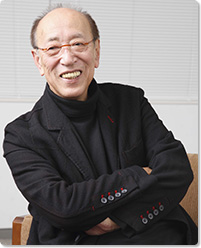
Photo: Shugyo Ohara
Yukio Ninagawa
Born in Saitama Pref. Artistic director of Sai-no-Kuni Saitama Arts Theater. Joined the theater company Gekidan Seihai in 1955 and founded the company Gekidan Gendaijin Gekijo in 1967. Made his debut as a theater director in 1969 with a production of Shinjo afururu keihakusa by Kunio Shimizu . Founded Sakura-sha with Kunio Shimizu and others in 1972. Following activities in these two companies, he became active as a commercial theater director with the Nissay Theater production of Romeo and Juliet . Since then he has continued to be one of Japan’s representative theater directors, presenting a string of highly acclaimed productions. Since assuming the artistic directorship of Sai-no-Kuni Saitama Arts Theater in 2006, he began a new challenge by launching the Saitama Gold Theater project for people over 55 years of age, once again attracting much attention in the society.
(Interview by Hiroshi Hasebe)
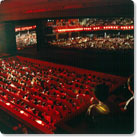
©Shochiku co.,Ltd.
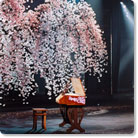
NINAGAWA Twelfth Night
Directed by Yukio Ninagawa
Date: July. 7-31, 2005
Venue: Kabuki-za Theater
Author: W. Shakespeare
Translation: Yuji Odajima
Playwright: Toyoshige Imai
Cast: Kikugoro Onoe
Kikunosuke Onoe
Sadanji Ichikawa
Tokizo Nakamura
Danshiro Ichikawa
Shinjiro Nakamura
Shoroku Onoe
Kamejiro Ichikawa
Kamesaburo Bando
Matsuya Onoe
Gonjuro Kawarazaki
Shucho Bando
Danzo Ichikawa
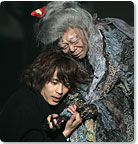
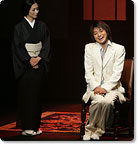
Modern Noh Play
—Sotoba-Komachi / Yoroboshi
(2005 / Saitama Arts Theater)
Photo: Naoya Ikegami

Macbeth
(2002 / Howard Gilman Opera House, NewYork)
Photo: Seiji Egawa
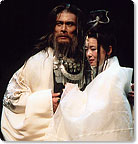
Pericles
(2003 / National Theatre, London)
Photo: Seiji Egawa

Related Tags

